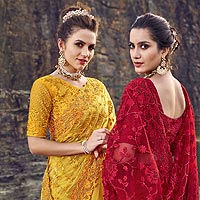Silk
What is a Silk fabric?Silk is a natural protein fibre, some of which can be woven into fabrics. Some specific insect larvae while getting moulded into cocoons, release fibroin, an insoluble protein,which help in the production of silk. The best-known silk is obtained from the cocoons of the mulberry silkworm Bombyx Mori.
Several insects can produce silk. But, usually, the silk of the moth caterpillars are used for textiles. The production of silk is known as sericulture.
What is the texture like?
Silk is smooth, has a very soft texture, which is not slippery unlike most other synthetic fibres.
How to handle Silk with care
- Wash you silk clothes with detergents fit for delicates.
- Do not tumble dry, twist or wring.
- Dry, placing it in between towels.
- After it has dried completely, iron it in low temperature, and store it in breathable cloth bags. Every six months, refold the outfit. Check for bugs and other insects.Â
Chiffon
What is a chiffon fabric?Chiffon is a translucent or sheer, lightweight, plain-woven fabric. This was originally made from silk and as a result was expensive and high in demand. Chiffon was first manufactured in France.
What is the texture like?
Chiffon has a light and slippery texture. It is very delicate and thus not used in apparels for daily use. There are quite a number of varieties available in the market.
How to handle chiffon with care?
- Chiffon is very delicate and must be hand washed very gently.
- Use a mild detergent.
- Do not wring or twist any chiffon garment, this will lead to bad creases.
- Dry it, away from the sunlight, by laying it flat.
Net
What is a net fabric?Net is any textile in which the yarns are looped, fused or knotted together at the intersections, which results to a fabric with open spaces between the yarns.
What is the texture like?
The net fabric can be made from different fibres like silk, acetate, polyester, nylon. How the texture of the net would be, depends upon the fibre it is made from. It can range from being fine, coarse or stiff. A silk net fabric would feel super soft, whereas a net fabric from nylon would feel stiff. Polyester netting can either be very soft or coarse. The net we wear are usually nylon net.
How to handle net with care?
- Blended varieties of net can be hand-washed using a mild detergent. It can also be machine washed in a gentle rinse cycle.
- But, the perfect way to maintain pure net garments are to dry-clean them.
Georgette
What is a georgette fabric?Georgette is a dull-finished, lightweight crepe fabric that has been named after a French dressmaker of the 20th century, Georgette de la Plante. Georgette has a light and drapey kind of feel, being best suited for loose, flowy garments. It is not an appropriate material for structured clothes. Georgette is of two types- pure and faux. While pure georgette is made from silk yarns, faux georgette is made from rayon and polyester fabrics.Â
What is the texture like?
Georgette is sheer, lightweight, available in solid colours and prints and are appropriate to make blouses, dresses, sarees, and evening gowns. Due to its thin texture, it is also very easy to handle.
How to handle georgette with care?
- For georgette sarees or skirts, hand washing is preferable.
- You can use a very mild detergent.
- Do not dry it under direct sunlight, as over exposure to sunlight will cause the fabric to lose its colour.
Lycra
What id Lycra fabric?Lycra is a type of a synthetic, elastane fibre that is stretchable to six times its original, and can again return back to its original shape. Nearly about 50 years ago, lycrawas first used as a substitute for rubber.
What is the texture like?
Lycra is flexible and stretchable. Lycra is known for being durable and its characteristics of drying faster than other fabrics.
How to handle Lycra with care?
- It is best to wash lycra or spandex in lukewarm water.
- Do not use any bleaching agent, or detergents that have traces of bleach as those may destroy the structure of the fibre.
- Do not wring or twist.
Banarasi Silk
What is Banarasi Silk?Banarasi silk or Benarasi silk is a finer variety of silk, that looks absolutely regal. It originates from the city of Varanasi in India. Banarasi Saree, which is woven from this silk, is extremely popular across the world.
A pure Banarasi silk saree is made from silk yarns, and embroidered with gold and silver threads. These sarees are very often a part of the Indian trousseau.
What is the texture like?
Banarasi silk is a durable silk, but proper care needs to be taken. It has a smooth finish and embroidery work is usually found on banarasi silk outfits, be it a saree, salwar suits, or a lehenga.
How to handle Banarasi Silk with care?
- Do not wash it for the first time with detergent. Soak it in a bucket full of salty water.
- Store these outfits separately, wrapped in soft cotton cloth.
- Remember to use light to medium heat while ironing.
- Practice refolding the silk garments in a span of every 3-4 months.
Velvet
What is Velvet fabric?Velvet is a type of a tufted, woven fabric in the threads are cut and distributed evenly, in a short dense pile. This gives it a distinctively soft feeling. A special loom is required to weave velvet, in which two thicknesses of the fabric is woven at the same time.
Making of velvet fabric is complicated, making it a comparatively expensive buy.
What is the texture like?
There are a number of types of velvet available and the textures vary from one another. Velvet has a unique texture, is patterned and shiny. A very high quality of velvet often feels soft like the coat of a furry animal.
How to handle Velvet with care?
- Clean velvet garments immediately after wearing, or hang in a well-ventilated area.
- Do not apply pressure when the garment is still wet.
- Shake excess moisture and then air dry.
- Do not iron velvet garments, rather use steam to remove wrinkles.
Cotton
What is a Cotton fabric?Cotton fabric is a soft, breathable one, made from well spun cotton fibre. The usage of cotton has been traced back to the prehistoric times. Cotton can be cultivated to have colours other than the yellowish off-white fibre. Naturally coloured cotton can also be made available in colours like red, green and some particular shades of brown.
What is the texture like?
Cotton is one of the most commonly used fabric used for clothing. The fabric is comfortable, breathable, stretchy, soft yet strong. It is ideal for dailywear, casualwear and loungewear.
How to handle Cotton with care?
- The best way to protect your clothes from bleeding is by washing them in cold water.
- Avoid hanging your wet cotton outfit on the clothesline, as it will stretch out the fabric.
- Cotton creases very easily and thus it is better to hang them rather folding it.
Jacquard
What is a Jacquard fabric?In a jacquard fabric, the pattern and colours are woven into the cloth directly, rather than being printed or dyed. The term ‘jacquard’ itself indicates the way a pattern is woven into the fabric.
How is the texture like?
A piece of jacquard clothing is durable and sturdy. It has a wrinkle-resistant feel, which is perfect for daily usage. Unlike prints or dyes, the woven patterns do not fade away with time.
How to handle jacquard with care?
- If a jacquard piece is too ornate or rich, with sequins or beadwork, do not risk it by washing it at home. Dry washing is the best for those.
- Avoid using bleaching agents for jacquard fabric.
- Do not twist or wring.
- Iron the jacquard fabric on the wrong side to ensure that you don’t damage the pattern.
Linen
What is a Linen fabric?Linen is a fabric usually made from the fibres of the flax plant. Textiles in the same texture as that of linen, even if made from cotton, hemp or other flax fibres are also referred to as ‘linen’.
What is the texture like?
Linen fibre, even after 6,000 years of its origin, is still winning our hearts because of its comfortable feel, breathable texture, and super absorbent nature. Linen is sturdy and sustainable in nature. Linen is also known for its notorious characteristic of being prone to wrinkles.
How to handle Linen with care?
- Always wash your linen clothes on your machine’s gentle cycle.
- If there is an option to choose the water level in the washing machine, choose the maximum.
- Let your linen clothing move about freely. Do not overcrowd the washing machine.
- Avoid using a fabric softener.
Crepe
What is a Crepe fabric?Crepe, is a fabric made of silk, wool or synthetic fibre fabric with a distinctively crimped or crisp appearance. It is also known as crape or crespe.
What is the texture like?
Crepe fabric has a pebbled or crinkled texture, and works great for blouses and dresses. The fibre can fine and opaque or thin and sheer, or even heavy.
How to handle Crepe with care?
- Most crepe garments, due to its composition, are to be dry-cleaned only.
- Crepe, if exposed to moisture for a long time, are susceptible to shrinkage.
- If the label of a particular crepe garment asks you that you can wash the particular outfit, you can do that using cool water and rinse it thoroughly. Avoid twisting or wringing it.
Chinon
What is a Chinon fabric?Chinon fabric is made up of a bright filament yarn which is woven with a highly twisted air-textured yarn. It gives a shiny look and is an excellent choice for flowy gowns or skirts, scarves, curtains, ruffled tops, etc.
What is the texture like?
Chinon is lustrous, is breathable and is a lightweight fabric.
How to handle Chinon with care?
- Garments made from Chinon fabric should be dry-cleaned always.
- It can be ironed using a steam iron of medium or low temperature.
Shantoon
What is a Shantoon fabric?Shantoon is a heavy fabric made with either silk fibres, or some form of synthetic fibres that are meant to be substituting for cotton filaments.
What is the texture like?
Shantoon is a sort of intricate weave. It is kind of a plain weave design, with a ribbed effect. Subbed yarns are used in the warp of the material giving this such clothing its texture.
How to handle Shantoon with care?
- Garments made from Chinon fabric should be dry-cleaned always.
- It can be ironed using a steam iron of medium or low temperature.
Satin
What is a Satin fabric?Satin is usually referred to a weave rather than a material. If a fabric is formed with a satin weave using a filament fibres, such as silk, polyester or nylon, the newly formed fabric is satin.
What is the texture like?
Satin usually has a glossy top surface anddull inner side. It has a high lustre or sheen quotient, unlike other weaves. Satin, undoubtedly, has a very luxurious feel and appearance, but it can be very difficult for tailors to deal with the fabric as it keeps is slippery!
How to handle Satin with care?
- Satin should be handwashed, or on the delicate cycle only, with cold water and a gentle detergent.
- Never hang a satin or wring satin to dry, as satin can lose shape easily.
- Do not try drying satin in the dryer. Instead, lay it flat on a clean towel to dry.
Viscose
What is a Viscose fabric?Viscose is a semi-synthetic rayon fabric made from the pulp of wood that is often used as a substitute for silk, or as artificial silk. The term “viscose” refers specifically to the solution of wood pulp that is turned into the fabric.
What is the texture like?
Viscose is light, soft, breathable and super absorbent. It doesn’t stick to the body, and is suitable to make sportswear or athleisure garments.
How to handle Viscose with care?
- Viscose clothing needs to be dry cleaned.
- If you want to wash it at home, use cold water and mild detergents. Do not wring or twist. Place it on a dry towel and let it dry.





